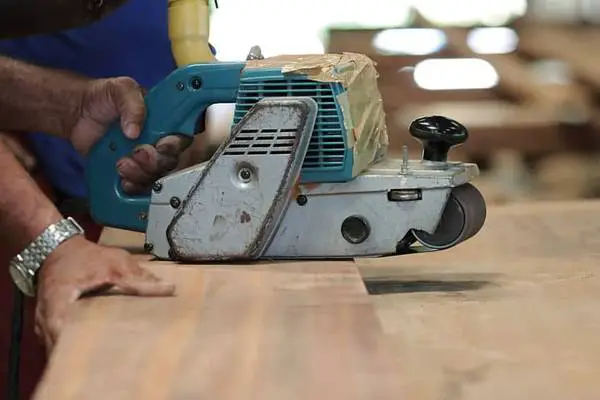
Bench Grinder vs Belt Sander: Which is Better for You?
Which is better for you? You may not need a bench grinder and you can get by with using a belt sander. And vice versa. Both tools have good points which make them a handy power tool to have around.
Bench Grinder vs Belt Sander: Which is better for you? We would like to say one or the other but it really depends on your hobbies, the type of projects you have and you. Each power tool has specific purposes that the other cannot do. So they are both important tools to own.
Just in case you cannot decide, we are going to explore both the bench grinder and belt sander competition. You can use the following information to help you decide which tool is best for you.
Belt Sander vs Grinder
It is time to see the purpose of each plus their good and bad points.
Belt sander:
As the name implies it uses sandpaper that looks like a belt to smooth rough surfaces. Those surfaces can be made of wood, plastic, and soft metals. It has a very powerful motor which drives the sandpaper at high speeds.
Pros:
- It can be mobile.
- Does its job very quickly.
- Can use a variety of grits with ease.
- Easy to change sandpaper belts.
- Removes a lot of material quickly.
Cons:
- Very noisy.
- Needs to keep moving or it can cause damage to the surface.
- Takes a lot of practice to master.
- Sandpaper belts can rip very easily.
- Doesn’t work for all jobs.
Bench Grinder:
This powerful tool is designed for the most part for sharpening tools, knives, blades, axes and a lot more items made from hard metals. Yet, it can also buff and polish when you put the right wheel on.
Pros:
- Powerful motor.
- Easy to change grinding wheels.
- Works quickly.
- Can hold a light.
- Easy to use.
Cons:
- Grinding wheels can break.
- Not meant for aluminum or plastic.
- Potential for serious injury.
- Many parts can break.
Bench Grinder vs Belt Sander for Sharpening

It is hands down that you would choose to use a bench grinder over a belt sander when you need to sharpen tools, etc. One main reason is that the bench grinder is specifically made to sharpen tools and other dull implements.
There is another good reason why you would choose to use the bench grinder instead of the belt sander. The bench grinder is stationary and locked to the workbench. This allows you to use both hands to get the nice clean edge you need to work.
There are some good stationary belt sanders on the market but their main purpose is not sharpening. The belts can easy rip if the metal on the tool is ragged or has a sharp chip. The bench grinder will take those situations in stride and get rid of them quickly.
Also, the bench grinder has different grit wheels that can really produce an edge on hard metals. Most belt sanders cannot bring the nice edge you need to your lawnmower blades, chisels and other tools.
If you are considering using a handheld belt sander to sharpen tools, don’t. It just is not feasible and makes tool sharpening inefficient.
Just keep in mind that the belt sander’s purpose is designed to smooth not sharpen tools. They can smooth out the edge to make sure there are no jagged points but sharpening is the bench grinder’s domain.
Bench Grinder or Belt Sander for Knife Making

Here we tip the hat to the belt sander. The bench grinder may be good for the initial rough work and get the basic shape of the knife. But the belt sander can do the fine tuning and really smooth out the metal.
Of course, it will depend on the metal you are using to make your knife. If you choose to use a soft metal, then the grinder is incapable of doing the job. You would need to turn to the belt sander to get the task completed.
One point in favor of the belt sander is that it won’t slow down if you put a lot of pressure on the belt. Also, many stationary belt sanders come with a dust collection system built-in. Most bench grinders do not.
This system keeps the dust away and helps you see what you are doing a lot better. Then, you can tilt most belt sanders and get the right angle that is best for you to work. Bench grinders do not tilt and you are stuck with one angle that may be uncomfortable and awkward.
Then some belt sanders have cast iron bases. This heavy construction material reduces vibration considerably making knife making easier on you.
Finally, even though we gave the edge to the belt sander here, we are a bit torn as we prefer to use a bench grinder when it comes to shaping and sharpening metals. But the belt sanders have good accessories that make knife building a lot easier and safer than using a bench grinder.
Similarities Between a Bench Grinder and a Belt Sander
Both tools have a lot of similarities which make them useful for tasks outside of their stated purpose. Here are a few of those similarities:
- Very powerful motors.
- Spin wheels and belts at high RPMs.
- Both can be used to remove rust.
- Both can smooth out wood.
- Both have a variety of grits that can be used.
Some Final Comments
To answer the question for us, we feel that the bench grinder is a better tool for us to use. The limitations on the belt sander, the easy tearing of the sanding belts and other negatives were too great for any positives to overcome.
The only real drawback to the bench grinder was the risk factor. You really have to be careful not to get snagged by the spinning wheels. Also, the versatility of the bench grinder helped make our decision.
As for you, you have to be the judge. You may like using a belt sander and feel you have more control over your project when you do. In the end, deciding which power tool is best for you, is a decision you have to make.

